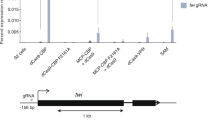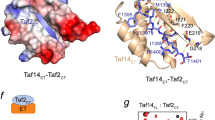Abstract
The GCN5 and ADA2 proteins are required for the activation function of a number of transcriptional activators in the yeast Saccharomyces cerevisiae. By using appropriate LexA fusion proteins we demonstrated that both proteins are required for part of the function of the GCN4, GAL4 and the VP16 transcriptional activation domains. Analysis of a gcn5 ada2 double disruption mutant did not reveal any additive effects, suggesting that the two proteins act in the same pathway. The GCN5 and ADA2 proteins can each activate transcription when directed to the promoter region of a reporter gene, but only in the presence of a wild-type ADA2 or GCN5 gene, respectively. The activation capacity is enhanced when the corresponding endogenous gene copy is disrupted. Taken together, these genetic data suggest that the two proteins interact and define one complex that mediates transcriptional activation. The function of this complex requires the bromodomain region of the GCN5 protein.
Similar content being viewed by others
References
Ammerer G (1983) Expression of genes in yeast using the ADHI promoter. Methods Enzymol 10:192–195
Berger SL, Pina B, Silverman N, Marcus GA, Agapite J, Regier JL, Triezenberg SJ, Guarente L (1992) Genetic isolation of ADA2: a potential transcription adaptor required for function of certain acidic activation domains. Cell 70:251–265
Cairns BR, Kim YJ, Sayre MH, Laurent BC, Kornberg RD (1994) A multisubunit complex containing the SWI1/ADR6, SWI2/ SNF2,SWI3, SNF5, and SNF6 gene products isolated from yeast. Proc Natl Acad Sci USA 91:1950–1954
Eckner R, Ewen ME, Newsome D, Gerdes M, DeCaprio JA, Lawrence JB, Livingston DM (1994) Molecular cloning and functional analysis of the adenovirus EIA-associated 300-kD protein (p300) reveals a protein with properties of a transcriptional adaptor. Genes Dev 8:869–884
Flanagan PM, Kelleher RJ III, Sayre MH, Tschochner H, Kornberg RD (1991) A mediator required for activation of RNA polymerase H transcription in vitro. Nature 350:436–438
Georgakopoulos T, Thireos G (1992) Two distinct yeast transcriptional activators require the function of the GCN5 protein to promote normal levels of transcription. EMBO J 11:4145–4152
Gyuris J, Golemic E, Chertkov H, Brent R (1993) Cdil, a human G1 and S phase protein phosphatase that associates with Cdk2. Cell 75:791–803
Hope IA, Struhl K (1986) Functional dissection of a eukaryotic transcriptional activator protein, GCN4 of yeast. Cell 46:885–894
Ingles CJ, Shales M, Cress WD, Triezenberg SJ, Greenblatt J (1991) Reduced binding of TF11D to trancriptionally compromised mutants of VP16. Nature 351:588–590
Ito H, Fokada Y, Murata K, Kimura A (1983) Transformation of intact yeast cells treated with alkali canons. J Bacteriol 153:163–168
Kelleher RJ III, Flanagan PM, Kornberg RD (1990) A novel mediator between activator proteins and the RNA polymerase 11 transcription apparatus. Cell 61:1209–1215
Kim TK, Hashimoto S, Kelleher R, Flanagan PM, Kornberg RD, Horikoshi M, Roeder RG (1994) Effects of activation-defective TBP mutations on transcription initiation in yeast. Nature 369:252–255
Kim YJ, Björklund S, Li Y, Sayre MH, Kornberg RD (1994) A multiprotein mediator of transcriptional activation and its interaction with the C-terminal repeat domain of RNA polymerase 11. Cell 77:599–608
Kretzschmar M, Meisterernst M, Roeder RG (1993) Identificaiton of human DNA topoisomerase I as a cofactor for activation-dependent transcription by RNA polymerase 11. Proc Natl Acad Sci USA 90:11508–11512
LaMarco K (1994) Dissecting a complex process. Proc Natl Acad Sci USA 91:2886–2887
Laurent BC, Carlson M (1992) Yeast SNF2/SWI2, SNF5, and SNF6 proteins function coordinately with the gene-specific transcriptional activators GAL4 and Bicoid. Genes Dev 7:1707–1715
Laurent BC, Xang X, Carlson M (1992) An essential S. cerevisiae gene homologous to SNF2 encodes a belie ase-related protein in a new family. Mol Cell Biol 12:1893–1902
Lin YS, Green MR (1991) Mechanism of action of an acidic transcriptional activator in vitro. Cell 64:971–981
Nishizawa M, Suzuki Y, Nogi Y, Matsumoto K, Fukasawa T (1990) Yeast Gal II protein mediates the transcriptional activation signal of two different transacting factors, Ga14 and general regulatory factor I/repressor/activator site-binding protein 1/ translation upstream factor. Proc Natl Acad Sci USA 87:715–724
Pina B, Berger S, Marcus GA, Silverman N, Agapite J, Guarente L (1993) ADA3: a gene, identified by resistance to GAL4-VP 16, with properties similar to and different from those of ADA2. Mol Cell Biol 13:5981–5989
Roberts SGE, Ha I, Maldonado E, Reinberg D, Green M (1993) Interaction between an acidic activator and transcription factor TFIIB is required for transcriptional activation. Nature 363:741–744
Rothstein R (1991) Targeting, disruption, replacement and allele rescue: integrative DNA transformation in yeast. Meth Enzymol 194:281–301
Ruppert D, Wang EH, Tjian R (1993) Cloning and expresion of human TAF11250:A TBP-associated factor implicated in cellcycle regulation. Nature 362:175–179
Sakurai H, Hiraoka Y, Fukasawa T (1993) Yeast GAL11 protein is a distinctive type transcription factor that enhances basal transcription in vitro. Proc Natl Acad Sci USA 90:8382–8386
Sherman F (1991) Getting started with yeast. Meth Enzymol 194:3–21
Sikorski RS, Hieter P (1989) A system of shuttle vectors and yeast host strains designed for efficient manipulation of DNA in Saccharomyces cerevisiae. Genetics 122:19–27
Stringer KF, Ingles CJ, Greenblatt J (1990) Direct and selective binding of an acidic transcription activation domain to the TATA-box factor TFIID. Nature 345:783–786
Suzuki Y, Nogi Y, Abe A, Fukasawa T (1988) GAL11 protein, an auxiliary transcription activator for genes encoding galactosemetabolizing enzymes in Saccharomyces cerevisiae. Mol Cell Biol 8:4911–4999
Tjian R, Maniatis T (1994) Transcriptional activation: a complex puzzle with few easy pieces. Cell 77:5–8
Tzamarias D, Struhl K (1994) Functional dissection of the yeast Cyc8-Tupl transcriptional co-repressor complex. Nature 369:758–761
Tzamarias D, Roussou I, Thireos G (1989) Coupling of GCN4 mRNA translational activation with decreased rates of polypeptide chain initiation. Cell 57:947–954
Wolffe AP (1994) Transcription: in tune with the histones. Cell 77:13–16
Author information
Authors and Affiliations
Additional information
Communicated by C. P. Hollenberg
Rights and permissions
About this article
Cite this article
Georgakopoulos, T., Gounalaki, N. & Thireos, G. Genetic evidence for the interaction of the yeast transcriptional co-activator proteins GCN5 and ADA2. Molec. Gen. Genet. 246, 723–728 (1995). https://doi.org/10.1007/BF00290718
Received:
Accepted:
Issue Date:
DOI: https://doi.org/10.1007/BF00290718




